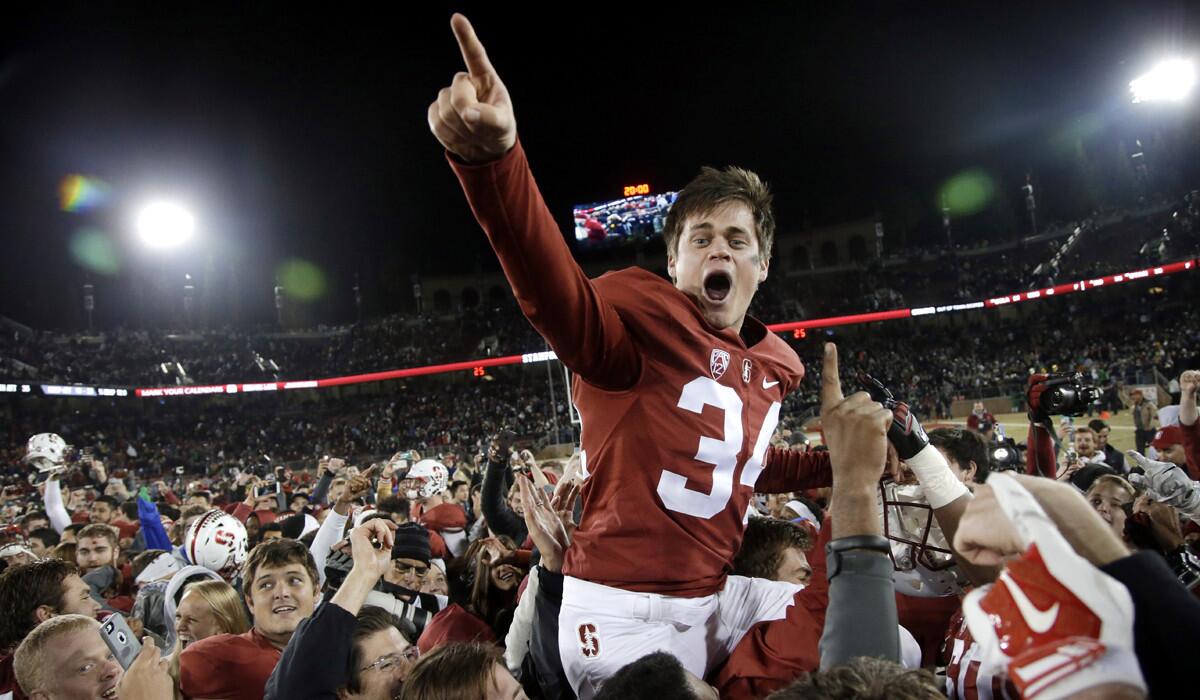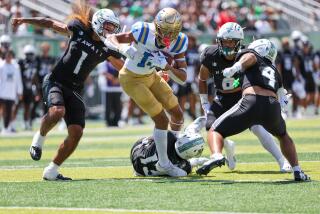Can Conrad Ukropina give Stanford a closing kick? He’s done so, memorably

Stanford place kicker Conrad Ukropina is lifted by fans and teammates after hitting a 45-yard field goal as time expired to give Stanford a 38-36 win over Notre Dame Nov. 28.
- Share via
Conrad Ukropina needed a strong leg, good technique and timing, supreme concentration and confidence and endless hours of practice to become the kicker he is today, the starter for a Stanford team that will play Iowa in the Rose Bowl on Friday.
He also caught a few breaks. Literally.
Ukropina, who grew up in Pasadena, about four miles from the Rose Bowl, enrolled at Los Angeles Loyola High in 2008 and won the starting quarterback job on the freshman team.
But a week before the first game, Ukropina got spun awkwardly during a tackling drill and sustained four fractures in his left forearm, an injury that sidelined him for two months.
“That was a bummer, but I had just made 100 new friends on the team so I really wanted to stay with them,” Ukropina said. “I had a cast on but went to practice every day. All I could do on the sideline was kick. I would literally kick the ball into a fence when I was bored. I kind of discovered a hidden talent.”
Ukropina played soccer but had never kicked a football before suffering that broken arm. In his first game, near the end of his freshman season, he made a 44-yard field goal. By his sophomore year, he was kicking for the Loyola varsity, and by his junior year he was training with a private coach.
During the summer before his senior year, Ukropina won the kickoff, punt and field-goal competitions at Stanford’s kicking camp, which ultimately led to a scholarship offer.
Now look at him: A redshirt junior on the sixth-ranked team in the nation, he’s made 17 of 19 field-goal attempts this season — including a dramatic 45-yard walk-off kick to give Stanford a 38-36 win over fourth-ranked Notre Dame on Nov. 28 — and all 61 of his extra-point attempts. He might even have a shot at the NFL.
“Isn’t it funny?” Ukropina said of his fortuitous break. “I don’t want to use the word fate, but there was some sense that that’s what was supposed to happen.”
Ukropina spent 2013 and 2014 as the backup to Cardinal career scoring leader Jordan Williamson before moving into the lead role this season. He thrived in the spotlight, kicking a pair of field goals in each of Stanford’s two wins over USC and his memory-maker against Notre Dame.
“He’s made some big kicks for us this year,” said Pete Alamar, Stanford’s special-teams coordinator. “He’s handled the stage well.”
That was evident against Notre Dame, which called timeout in an attempt to distract Ukropina.
“We knew they were going to ice him, so I said, ‘Come back over, we’ll talk for a few minutes, then come off the sideline ready to make the kick,’” Alamar recalled. “He said, ‘Hey, I got this.’ You could tell by looking in his eyes that he was supremely confident he was going to make that kick.”
Ukropina got the rock-star treatment afterward. Joshua Garnett, Stanford’s 6-foot-5, 321-pound left guard, lifted Ukropina onto his shoulders and carried him off the field, the jubilant kicker screaming to every television camera he saw.
Ukropina remained on the field for almost an hour after the game doing interviews, posing for pictures and signing autographs.
“I told him to stay as long as you want, because this is a once-in-a-lifetime opportunity,” said Bill Ukropina, Conrad’s father. “He was a mini-celebrity the whole night.”
Ukropina felt prepared for his most pressure-packed kick. At the end of every practice last summer, Coach David Shaw lined up the field-goal unit for a snap, hold and kick, instructing the rest of the team to scream at Ukropina, wave their arms, get in his face.
If Ukropina makes the kick, running workouts the next day are easier. If he misses, they are grueling.
“I went 12 for 12 from all different lengths,” Ukropina said. “That cheer from my teammates when I make it, honestly, that’s what I live for. That was a huge confidence-builder for me.”
A month after the Notre Dame kick, it’s still a topic of conversation.
“A lot of people say, ‘Oh, how did you make that one kick?’” Ukropina said. “I say that wasn’t just one kick to me. It was a body of thousands of kicks I did in the off-season, in training and over the summer.”
And in cyberspace. Ukropina is one of several Stanford athletes experimenting with the STRIVR virtual reality program being developed by Stanford professor Jeremy Bailenson.
Ukropina, a science, technology and society major, will begin working with Bailenson next spring while the kicker studies virtual reality and its effects on the brain as part of his master’s degree program.
STRIVR shoots images with a 360-degree camera — in Ukropina’s case, it captures the form and technique of his best kicks — and players can later go through reps with a virtual reality headset.
“From a visualization standpoint, it’s unbelievable,” Ukropina said. “I can see myself make kicks in practice. I’ll use it before the game. It’s a great confidence boost because I can see myself make field goals.”
Bill Ukropina can only imagine what it would be like if Conrad delivers another walk-off game-winner against Iowa.
Bill took Conrad and his two other sons to the Rose Parade and Rose Bowl game just about every year, and he rents out the visiting locker room in the Rose Bowl for his annual Christmas party.
Through his contacts with the Tournament of Roses committee and Washington State, his alma mater, he was able to procure 93 tickets for Friday’s game for relatives and friends.
“We’ve attended so many Rose Bowl games, and now, to have my son run onto the field as a starter, it’s like a happy miracle in life,” Bill said. “If he won the game with a kick, I think I’d cry. It would be overwhelming.”
Twitter: @MikeDiGiovanna
More to Read
Go beyond the scoreboard
Get the latest on L.A.'s teams in the daily Sports Report newsletter.
You may occasionally receive promotional content from the Los Angeles Times.











